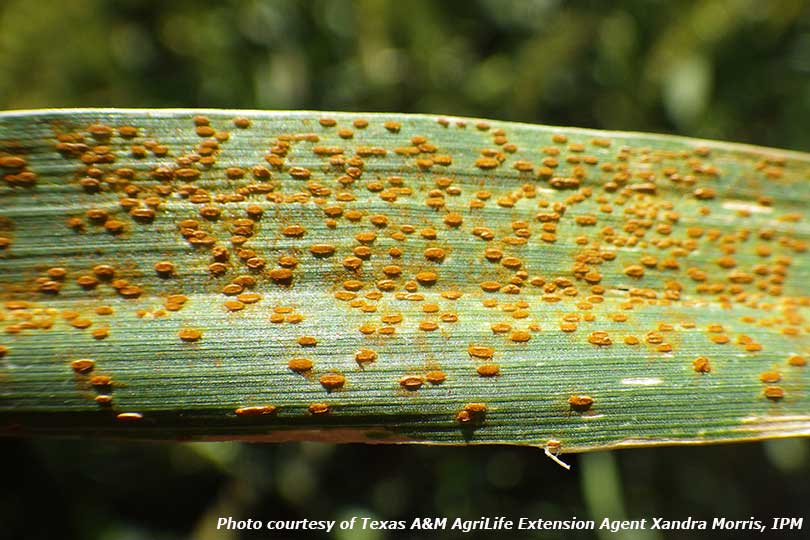By Shala Watson
Multimedia Writer
Texas had the warmest winter on record dating back to 1907, according to the state climatologist John Nielsen-Gammon.
The warmer temperatures caused wheat crops to grow at an accelerated rate, about two weeks or more ahead of last year, according to Xandra Morris, Texas A&M AgriLife Extension agent and IPM for Hill County.
Morris noted unusually warm conditions and periodic rains have contributed to high disease pressure this year. Leaf rust has increased significantly in some fields that were not treated at topdress.
“Leaf rust prefers temperatures around 68-77 degrees,” Morris said. “It can survive at much higher temperatures so just because we get a temperature spike doesn’t mean that it’s going to kill off the leaf rust. They’ve been shown to survive 85 degrees and higher.”
Leaf rust is mainly found in wheat and moist conditions are ideal for the disease to spread this spring.
“Rust of all kinds does require moisture on the leaf’s surface—that can be from rain or dew—for the spores to germinate,” Morris said. “Humidity in the lower canopy can definitely help spread the rust as well.”
Field scouting to identify leaf rust early in the growing season is critical to maintain control and to prevent yield losses.
Most fields, regardless of variety, are showing signs of flecking of the upper leaves, according to Morris. Flecking, which is the first sign of leaf rust development, is the lighter dots in the leaf where the cells are dead.
But Morris said farmers shouldn’t automatically assume they will see leaf rust if signs of flecking are present.
“There are some varieties that show flecking naturally, even in the absence of disease,” Morris said.
Leaf rust is a concern when pustules develop three or four days later after heavy flecking in fields. The fungus pustules kill plant cells and reduce the photosynthetic abilities of the leaf, which leads to yield loss.
Fields with heavy rust pressure may benefit from a treatment at Feekes growth stage 10 or boot stage once the head develops and is visible in the leaf sheath directly below the flag leaf, Morris said.
Rust on the flag leaf causes the most yield loss at flowering.
“When your wheat is at flowering, if the rust pustules are covering 10 percent of the flag leaf, you can expect a 10 percent yield loss,” Morris said. “At 40 percent coverage of the flag leaf at flowering, you can see a 20 percent yield loss.”
The best time to apply a fungicide to treat for leaf rust is at flag leaf emergence.
“You’re going to protect the flag leaf with the fungicide for about two weeks,” Morris said. “That’s when it’s in its most vulnerable stage in that two-week window when it starts flowering.”
Good leaf coverage with a fungicide is also important when treating for leaf rust.
“Put out plenty of gallons of water per acre with that fungicide,” Morris said. “You want to penetrate into the canopy as much as you can.”
There are preventative and treatment fungicides available for leaf rust. Strobilurins prevent spore germination and can be used as a preventative. Triazoles, such as propiconazoles and tebuconazoles, affect the fungus as it’s growing, according to Morris.
“At flag leaf, people will typically apply triazoles, which offer two weeks of protection,” Morris said.
Any field is susceptible to an infection or infestation, because rust spores are carried by the wind. The majority of rust originates in Mexico and makes its way onto early planted crops in Texas.
An isolated case of Wheat Streak Mosaic Virus (WSMV) has also been identified in Williamson County, according to Morris. But it’s typically not a problem in the general Blacklands area.
Morris said the symptoms of WSMV are not very distinct and plants must be sent into a laboratory for testing to determine whether or not the plant has the disease. The virus causes stunting and yellowing of the leaves, which leads to yield losses.
The virus is best managed by controlling volunteer wheat.
“WSMV is spread by the wheat curl mite, which persists on volunteer wheat, millet and oats,” Morris said. “Nothing can be done to cure the wheat once it is infected.”
WSMV often starts on the edge of the field and may appear off-color, according to Dr. Charles Rush, Texas A&M AgriLife Research and E

